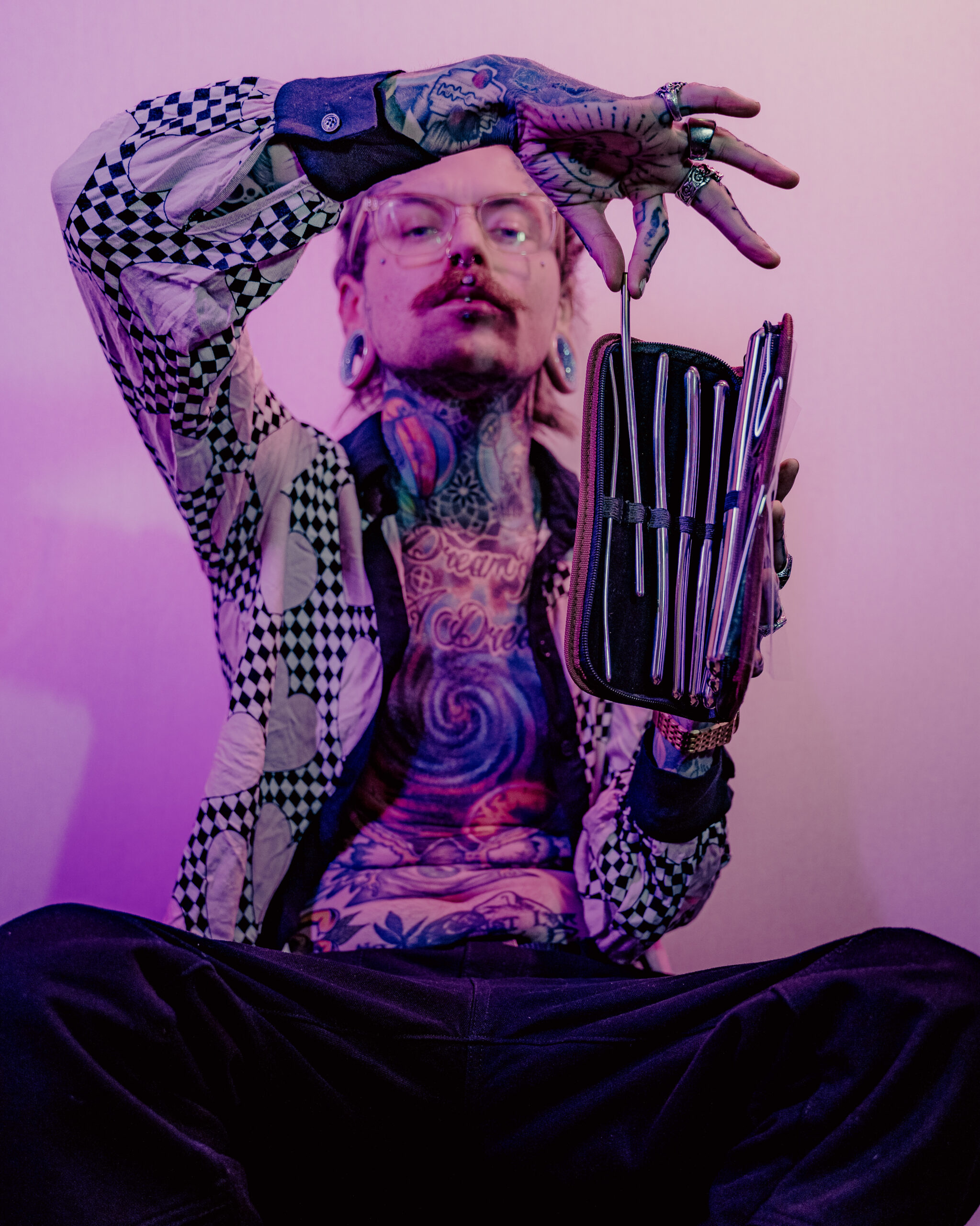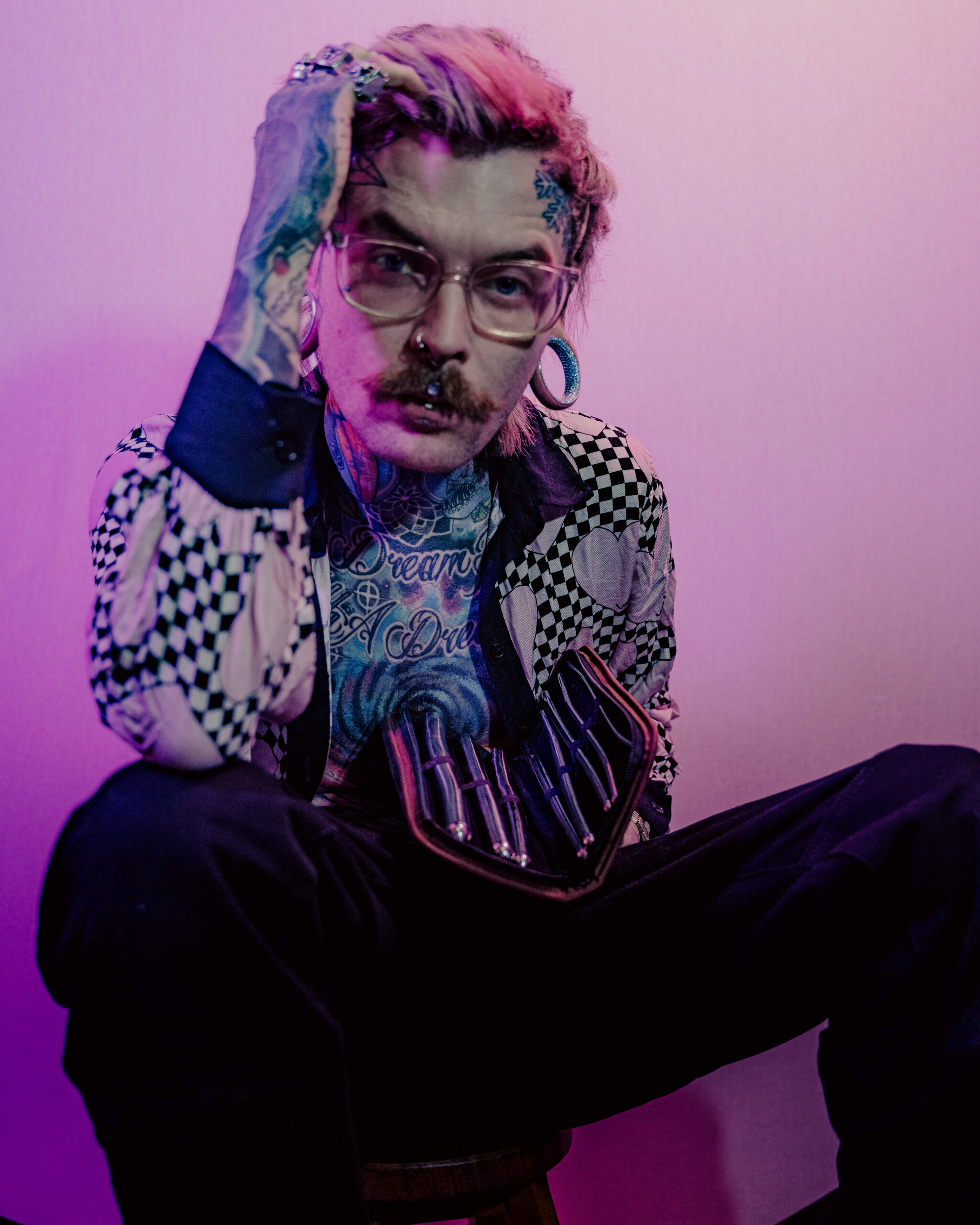Defining Androgyny
Androgyny, a concept that has captivated artists, writers, and thinkers for centuries, explores the beautiful fluidity between traditionally defined masculine and feminine traits. It celebrates the dismantling of rigid gender binaries and embraces a spectrum of expression where individuals can seamlessly blend characteristics often perceived as opposites.
Historical Perspectives on Androgyny
Historically, the perception and acceptance of androgyny have been diverse and ever-evolving. In ancient cultures, such as Greece and Rome, androgyny was often celebrated in art and mythology, representing ideals of beauty, harmony, and spiritual completeness. Figures like Hermes and Heracles embodied both masculine strength and feminine grace.
However, with the rise of rigid gender roles during the Renaissance and Enlightenment eras, androgyny began to be viewed with suspicion. It was often associated with ambiguity, disorder, and a threat to societal norms.
Throughout the 20th century, movements like feminism and LGBTQ+ rights helped to challenge traditional gender constructs. Androgyny gained renewed attention as a symbol of liberation and self-expression.
Today, androgyny continues to be embraced as a powerful means of challenging societal expectations and celebrating individual uniqueness. It manifests in various ways, from fashion choices and personal style to artistic expression and gender identity.
Modern Interpretations of Androgyny
Modern interpretations of androgyny are incredibly diverse and reflect the evolving understanding of gender identity and expression.
- Fashion has become a prominent avenue for expressing androgyny, with blurring lines between traditionally masculine and feminine clothing styles.
- Celebrities like David Bowie and Billy Porter have pushed boundaries with their flamboyant androgynous looks, inspiring others to embrace self-expression without constraints.
- In art, androgyny is explored through diverse mediums, from painting and sculpture to photography and performance art. Artists often challenge conventional representations of gender and create works that celebrate fluidity and nonconformity.
Ultimately, modern interpretations of androgyny emphasize the beauty of individuality and the right to express oneself authentically, regardless of societal expectations.
Cultural Variations in Androgyny
Androgyny is a concept that blurs the lines between traditionally masculine and feminine traits. It celebrates a spectrum of gender expression where individuals can embrace a blend of characteristics often perceived as opposites.
Cultural perceptions of androgyny have shifted throughout history. In ancient societies, androgyny was often embraced as a symbol of beauty and harmony. For example, figures like Hermes and Heracles in Greek mythology embodied both masculine strength and feminine grace.
During the Renaissance and Enlightenment eras, rigid gender roles became more prominent, leading to a shift in views on androgyny. It was often seen as ambiguous and disruptive to societal norms.
Modern interpretations of androgyny are diverse and reflect evolving understandings of gender identity and expression. Fashion has become a significant avenue for expressing androgyny, with designers blurring the lines between traditionally masculine and feminine clothing styles.
Celebrities like David Bowie and Billy Porter have used their platform to champion androgynous looks, encouraging self-expression without limitations.
In art, androgyny is explored through various mediums, challenging conventional representations of gender and celebrating fluidity and nonconformity.
Androgyny in Fashion and Style
Androgyny, the captivating blending of traditionally masculine and feminine traits, has long fascinated artists, writers, and thinkers. It dismantles rigid gender binaries and celebrates a spectrum of expression where individuals can seamlessly weave together characteristics often perceived as opposites.
Challenging Traditional Gender Norms through Clothing
Modern interpretations of androgyny are incredibly diverse and reflect the evolving understanding of gender identity and expression. Fashion has become a prominent avenue for expressing androgyny, with blurring lines between traditionally masculine and feminine clothing styles.
Celebrities like David Bowie and Billy Porter have pushed boundaries with their flamboyant androgynous looks, inspiring others to embrace self-expression without constraints. In art, androgyny is explored through diverse mediums, from painting and sculpture to photography and performance art. Artists often challenge conventional representations of gender and create works that celebrate fluidity and nonconformity.
Ultimately, modern interpretations of androgyny emphasize the beauty of individuality and the right to express oneself authentically, regardless of societal expectations.
Expression through Makeup, Accessories, and Hairstyles
Androgyny has become a powerful force in contemporary culture, challenging traditional notions of gender expression and celebrating the fluidity of identity. It encourages individuals to embrace a spectrum of traits often perceived as distinctly masculine or feminine, blurring the lines between these categories.
- Fashion serves as a key platform for expressing androgyny, with designers increasingly incorporating elements traditionally associated with both genders into their collections.
- Makeup artistry has also become an integral tool for exploring androgynous aesthetics. The use of bold colors, unconventional eyeliner styles, and gender-bending makeup looks allows individuals to experiment with different expressions of self.
- Accessories, too, play a vital role in crafting an androgynous style. Think tailored jackets paired with delicate jewelry, masculine footwear juxtaposed with feminine handbags, or the inclusion of gender-neutral pieces like scarves or hats.
- Hairstyles also contribute to the creation of androgynous looks. Short cuts, long hair styled in a masculine manner, shaved sides, and unconventional braids all offer opportunities for individuals to experiment with different expressions of their identity.
The beauty of androgyny lies in its ability to empower individuals to define themselves beyond restrictive societal norms. It encourages self-discovery, creativity, and the celebration of individuality in all its forms.
Celebrities as Influencers of Androgyny in Fashion
Androgyny is a concept that challenges traditional notions of gender by blending traditionally masculine and feminine traits.
Fashion has become a powerful platform for expressing androgyny, blurring the lines between clothing typically associated with men and women. Designers are incorporating elements like tailored suits paired with flowing skirts, menswear-inspired silhouettes in feminine fabrics, and accessories that defy traditional gender boundaries.
Celebrities have played a significant role in popularizing androgynous fashion. Icons like David Bowie and Tilda Swinton have consistently pushed the boundaries of gender expression through their bold and innovative style choices, inspiring others to embrace individuality and experiment with non-conformist looks.
Modern interpretations of androgyny are diverse and personal, reflecting a growing acceptance of fluid gender identities. It’s not about adhering to strict rules or creating a specific look but rather about expressing oneself authentically and celebrating the spectrum of human expression.
Androgyny in Art and Literature
Androgyny, a concept that has captivated artists, writers, and thinkers for centuries, explores the beautiful fluidity between traditionally defined masculine and feminine traits. It celebrates the dismantling of rigid gender binaries and embraces a spectrum of expression where individuals can seamlessly blend characteristics often perceived as opposites.
Iconic Examples of Androgynous Characters
Androgyny is a concept that has captivated artists, writers, and thinkers for centuries, exploring the beautiful fluidity between traditionally defined masculine and feminine traits. It celebrates the dismantling of rigid gender binaries and embraces a spectrum of expression where individuals can seamlessly blend characteristics often perceived as opposites.
Historically, the perception and acceptance of androgyny have been diverse and ever-evolving. In ancient cultures, such as Greece and Rome, androgyny was often celebrated in art and mythology, representing ideals of beauty, harmony, and spiritual completeness. Figures like Hermes and Heracles embodied both masculine strength and feminine grace.
However, with the rise of rigid gender roles during the Renaissance and Enlightenment eras, androgyny began to be viewed with suspicion. It was often associated with ambiguity, disorder, and a threat to societal norms.
Throughout the 20th century, movements like feminism and LGBTQ+ rights helped to challenge traditional gender constructs. Androgyny gained renewed attention as a symbol of liberation and self-expression.
Today, androgyny continues to be embraced as a powerful means of challenging societal expectations and celebrating individual uniqueness. It manifests in various ways, from fashion choices and personal style to artistic expression and gender identity.
- Fashion has become a prominent avenue for expressing androgyny, with blurring lines between traditionally masculine and feminine clothing styles.
- Celebrities like David Bowie and Billy Porter have pushed boundaries with their flamboyant androgynous looks, inspiring others to embrace self-expression without constraints.
- In art, androgyny is explored through diverse mediums, from painting and sculpture to photography and performance art. Artists often challenge conventional representations of gender and create works that celebrate fluidity and nonconformity.
Ultimately, modern interpretations of androgyny emphasize the beauty of individuality and the right to express oneself authentically, regardless of societal expectations.
Themes of Gender Fluidity and Identity Exploration
Androgyny, a concept that has captivated artists, writers, and thinkers for centuries, explores the beautiful fluidity between traditionally defined masculine and feminine traits. It celebrates the dismantling of rigid gender binaries and embraces a spectrum of expression where individuals can seamlessly blend characteristics often perceived as opposites.
Historically, the perception and acceptance of androgyny have been diverse and ever-evolving. In ancient cultures, such as Greece and Rome, androgyny was often celebrated in art and mythology, representing ideals of beauty, harmony, and spiritual completeness. Figures like Hermes and Heracles embodied both masculine strength and feminine grace.
However, with the rise of rigid gender roles during the Renaissance and Enlightenment eras, androgyny began to be viewed with suspicion. It was often associated with ambiguity, disorder, and a threat to societal norms.
Throughout the 20th century, movements like feminism and LGBTQ+ rights helped to challenge traditional gender constructs. Androgyny gained renewed attention as a symbol of liberation and self-expression.
Today, androgyny continues to be embraced as a powerful means of challenging societal expectations and celebrating individual uniqueness. It manifests in various ways, from fashion choices and personal style to artistic expression and gender identity.
- Fashion has become a prominent avenue for expressing androgyny, with blurring lines between traditionally masculine and feminine clothing styles.
- Celebrities like David Bowie and Billy Porter have pushed boundaries with their flamboyant androgynous looks, inspiring others to embrace self-expression without constraints.
- In art, androgyny is explored through diverse mediums, from painting and sculpture to photography and performance art. Artists often challenge conventional representations of gender and create works that celebrate fluidity and nonconformity.
Ultimately, modern interpretations of androgyny emphasize the beauty of individuality and the right to express oneself authentically, regardless of societal expectations.
The Evolution of Androgyny in Artistic Expression
Androgyny, a concept that has captivated artists, writers, and thinkers for centuries, explores the beautiful fluidity between traditionally defined masculine and feminine traits. It celebrates the dismantling of rigid gender binaries and embraces a spectrum of expression where individuals can seamlessly blend characteristics often perceived as opposites.
Historically, the perception and acceptance of androgyny have been diverse and ever-evolving. In ancient cultures, such as Greece and Rome, androgyny was often celebrated in art and mythology, representing ideals of beauty, harmony, and spiritual completeness. Figures like Hermes and Heracles embodied both masculine strength and feminine grace.
However, with the rise of rigid gender roles during the Renaissance and Enlightenment eras, androgyny began to be viewed with suspicion. It was often associated with ambiguity, disorder, and a threat to societal norms.
Throughout the 20th century, movements like feminism and LGBTQ+ rights helped to challenge traditional gender constructs. Androgyny gained renewed attention as a symbol of liberation and self-expression.
Today, androgyny continues to be embraced as a powerful means of challenging societal expectations and celebrating individual uniqueness. It manifests in various ways, from fashion choices and personal style to artistic expression and gender identity.
Fashion has become a prominent avenue for expressing androgyny, with blurring lines between traditionally masculine and feminine clothing styles. Celebrities like David Bowie and Billy Porter have pushed boundaries with their flamboyant androgynous looks, inspiring others to embrace self-expression without constraints. In art, androgyny is explored through diverse mediums, from painting and sculpture to photography and performance art. Artists often challenge conventional representations of gender and create works that celebrate fluidity and nonconformity.
Ultimately, modern interpretations of androgyny emphasize the beauty of individuality and the right to express oneself authentically, regardless of societal expectations.
The Social Impact of Androgyny
Androgyny, a concept that has captivated artists, writers, and thinkers for centuries, explores the beautiful fluidity between traditionally defined masculine and feminine traits. It celebrates the dismantling of rigid gender binaries and embraces a spectrum of expression where individuals can seamlessly blend characteristics often perceived as opposites.
Androgyny is a powerful force in contemporary culture, challenging traditional notions of gender expression and celebrating the fluidity of identity. It encourages individuals to define themselves beyond restrictive societal norms.
Shifting Societal Attitudes towards Gender Roles
Androgyny, a concept that has captivated artists, writers, and thinkers for centuries, explores the beautiful fluidity between traditionally defined masculine and feminine traits. It celebrates the dismantling of rigid gender binaries and embraces a spectrum of expression where individuals can seamlessly blend characteristics often perceived as opposites.
Historically, the perception and acceptance of androgyny have been diverse and ever-evolving. In ancient cultures, such as Greece and Rome, androgyny was often celebrated in art and mythology, representing ideals of beauty, harmony, and spiritual completeness. Figures like Hermes and Heracles embodied both masculine strength and feminine grace.
However, with the rise of rigid gender roles during the Renaissance and Enlightenment eras, androgyny began to be viewed with suspicion. It was often associated with ambiguity, disorder, and a threat to societal norms.
Throughout the 20th century, movements like feminism and LGBTQ+ rights helped to challenge traditional gender constructs. Androgyny gained renewed attention as a symbol of liberation and self-expression.
Today, androgyny continues to be embraced as a powerful means of challenging societal expectations and celebrating individual uniqueness. It manifests in various ways, from fashion choices and personal style to artistic expression and gender identity.
Fashion has become a prominent avenue for expressing androgyny, with blurring lines between traditionally masculine and feminine clothing styles. Celebrities like David Bowie and Billy Porter have pushed boundaries with their flamboyant androgynous looks, inspiring others to embrace self-expression without constraints. In art, androgyny is explored through diverse mediums, from painting and sculpture to photography and performance art. Artists often challenge conventional representations of gender and create works that celebrate fluidity and nonconformity.
Ultimately, modern interpretations of androgyny emphasize the beauty of individuality and the right to express oneself authentically, regardless of societal expectations.
Celebrating Diversity and Individuality
Androgyny is a concept that has captivated artists, writers, and thinkers for centuries, exploring the beautiful fluidity between traditionally defined masculine and feminine traits. It celebrates the dismantling of rigid gender binaries and embraces a spectrum of expression where individuals can seamlessly blend characteristics often perceived as opposites.
Historically, the perception and acceptance of androgyny have been diverse and ever-evolving. In ancient cultures, such as Greece and Rome, androgyny was often celebrated in art and mythology, representing ideals of beauty, harmony, and spiritual completeness. Figures like Hermes and Heracles embodied both masculine strength and feminine grace.
However, with the rise of rigid gender roles during the Renaissance and Enlightenment eras, androgyny began to be viewed with suspicion. It was often associated with ambiguity, disorder, and a threat to societal norms. Throughout the 20th century, movements like feminism and LGBTQ+ rights helped to challenge traditional gender constructs. Androgyny gained renewed attention as a symbol of liberation and self-expression.
Today, androgyny continues to be embraced as a powerful means of challenging societal expectations and celebrating individual uniqueness. It manifests in various ways, from fashion choices and personal style to artistic expression and gender identity.
Fashion has become a prominent avenue for expressing androgyny, with blurring lines between traditionally masculine and feminine clothing styles. Celebrities like David Bowie and Billy Porter have pushed boundaries with their flamboyant androgynous looks, inspiring others to embrace self-expression without constraints. In art, androgyny is explored through diverse mediums, from painting and sculpture to photography and performance art. Artists often challenge conventional representations of gender and create works that celebrate fluidity and nonconformity.
Ultimately, modern interpretations of androgyny emphasize the beauty of individuality and the right to express oneself authentically, regardless of societal expectations.
Challenges and Discrimination Faced by Androgynous Individuals
Androgyny, a concept that has captivated artists, writers, and thinkers for centuries, explores the beautiful fluidity between traditionally defined masculine and feminine traits. It celebrates the dismantling of rigid gender binaries and embraces a spectrum of expression where individuals can seamlessly blend characteristics often perceived as opposites.
Throughout history, the perception and acceptance of androgyny have varied significantly. In ancient cultures such as Greece and Rome, androgyny was often celebrated in art and mythology, symbolizing ideals of beauty, harmony, and spiritual completeness. Figures like Hermes and Heracles embodied both masculine strength and feminine grace, showcasing the allure of this blend.
However, with the rise of rigid gender roles during the Renaissance and Enlightenment eras, androgyny began to face suspicion. It was often associated with ambiguity, disorder, and a challenge to societal norms, leading to its marginalization.
Thankfully, the 20th century witnessed a shift in attitudes towards androgyny. Movements like feminism and LGBTQ+ rights helped dismantle traditional gender constructs, paving the way for greater acceptance of diverse expressions of gender identity.
Today, androgyny continues to be embraced as a powerful force for challenging societal expectations and celebrating individual uniqueness. It manifests in various ways, from fashion choices and personal style to artistic expression and gender identity.
Fashion has become a prominent avenue for expressing androgyny, with designers blurring the lines between traditionally masculine and feminine clothing styles. Celebrities like David Bowie and Billy Porter have pushed boundaries with their flamboyant androgynous looks, inspiring others to embrace self-expression without constraints.
In art, androgyny is explored through diverse mediums, challenging conventional representations of gender and celebrating fluidity and nonconformity.
Androgyny’s enduring appeal lies in its celebration of individuality and the right to express oneself authentically, regardless of societal pressures. It empowers individuals to define their own identities beyond restrictive norms and embrace the beauty of self-expression.
Androgyny and Self-Expression
Androgyny, a concept that has captivated artists, writers, and thinkers for centuries, explores the beautiful fluidity between traditionally defined masculine and feminine traits. It celebrates the dismantling of rigid gender binaries and embraces a spectrum of expression where individuals can seamlessly blend characteristics often perceived as opposites.
Throughout history, the perception and acceptance of androgyny have varied significantly. In ancient cultures such as Greece and Rome, androgyny was often celebrated in art and mythology, symbolizing ideals of beauty, harmony, and spiritual completeness. Figures like Hermes and Heracles embodied both masculine strength and feminine grace, showcasing the allure of this blend.
However, with the rise of rigid gender roles during the Renaissance and Enlightenment eras, androgyny began to face suspicion. It was often associated with ambiguity, disorder, and a challenge to societal norms, leading to its marginalization. Thankfully, the 20th century witnessed a shift in attitudes towards androgyny. Movements like feminism and LGBTQ+ rights helped dismantle traditional gender constructs, paving the way for greater acceptance of diverse expressions of gender identity.
Today, androgyny continues to be embraced as a powerful force for challenging societal expectations and celebrating individual uniqueness. It manifests in various ways, from fashion choices and personal style to artistic expression and gender identity.
Fashion has become a prominent avenue for expressing androgyny, with designers blurring the lines between traditionally masculine and feminine clothing styles. Celebrities like David Bowie and Billy Porter have pushed boundaries with their flamboyant androgynous looks, inspiring others to embrace self-expression without constraints. In art, androgyny is explored through diverse mediums, challenging conventional representations of gender and celebrating fluidity and nonconformity.
Androgyny’s enduring appeal lies in its celebration of individuality and the right to express oneself authentically, regardless of societal pressures. It empowers individuals to define their own identities beyond restrictive norms and embrace the beauty of self-expression.

Embracing a Fluid Sense of Identity
This is a well-written and informative piece on androgyny. Here are some suggestions for improvement:
**Structure:**
* **Break up long paragraphs:** Some paragraphs are quite dense. Consider breaking them into shorter, more manageable chunks to improve readability.
* **Stronger transitions:** Consider adding transition words or phrases between paragraphs to create a smoother flow of ideas.
**Content:**
* **Specificity:** While you provide good general information, incorporating specific examples (beyond Bowie and Porter) from fashion, art, or history would strengthen your points.
* **Deeper Exploration:** Consider delving deeper into the different ways androgyny is expressed in various cultures and throughout time. You touch on this briefly, but expanding on it would add richness to your piece.
**Style:**
* **Vary sentence structure:** The writing relies heavily on similar sentence structures. Experimenting with different sentence lengths and types will make the text more engaging.
Overall, you have a strong foundation for a compelling article on androgyny. By implementing these suggestions, you can elevate it to an even higher level.
Breaking Free from Gender Stereotypes
Thank you for the constructive feedback! I appreciate your insights and suggestions for improvement. I’ll definitely work on incorporating them to make the piece more engaging and informative.
Your points about:
* **Paragraph length and transitions:** Are well taken, and I’ll focus on making the text flow better.
* **Specificity:** I agree that concrete examples would add depth, and I’ll brainstorm some to illustrate the various facets of androgyny.
* **Deeper exploration:** I see potential to delve further into cultural and historical contexts to provide a richer understanding.
Your observation about sentence structure is also helpful; I’ll aim for more variety to enhance readability.
Thank you again for your valuable feedback! It’s incredibly helpful in improving my writing.
The Empowerment that Comes with Androgyny
You’re very welcome! I’m glad my feedback was useful. Remember, writing is a process of continual learning and refinement. Don’t be afraid to experiment and try new things as you develop your craft further.
If you have any other questions or need more feedback in the future, feel free to ask! Happy writing!
Find condoms designed for better safety and performance

Shop for bulk condoms for your long-term protection
Shop for ultra-thin protection for a seamless experience
Find ribbed and warming condoms for extra enjoyment
Buy novelty flavoured and coloured products for ultimate pleasure
Explore regular and natural items for extra reliability
Find Control Condoms for satisfying results
Order Safe and Strong for powerful protection
- Why CBD Gummy Sweets Are The Hottest Trend In The UK - November 8, 2025
- What Is The Best Non Surgical Face Tightening Procedure? - November 5, 2025
- What Are The Benefits Of Taking CBD Gummies For Skin Conditions Like Eczema? - November 3, 2025


